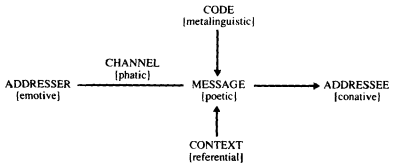This model defines function (contained in square brackets in Figure 1) in terms of the aspect of the communicative event (shown in upper case) on which the language is focused and to set this within a general model of human communication:

FIGURE 1 Domain of discourse: language functions
The notion of 'focus' is very helpful. Adult utterances (in contrast with those of pre-school children) are typically ambiguous (i.e. multifunctional) and to think in terms of the meaning or function of an utterance (or text) is naive. The problem is to discover the primary meaning (the focus) and this resolves itself into asking 'whose meaning?"; the meaning/focus intended by the addresser (the sender) or that decoded from the text by the addressee (the receiver)?
Fortunately, we do not need to address this question yet and can continue with an explanation of the model in spite of the ambiguity of reference.
Referential function. Here the focus is on the denotative content of the message; the subject-matter. As its name suggests, this function is oriented towards referring to entities, states, events and relationships which constitute the 'real world' of our experiences and are represented in the propositions which underlie texts. We have met this function already in the discussion of cognitrve meaning and the ideational macrofunction of language. Since it is concerned with the face-value, semantic sense of utterances, this function has, as we noted earlier, tended to be thought of as the function of language by the linguistically unsophisticated but, given that language is typically multifunctional, it is difficult to find an example of language in use which is only referential. The best we can do, for this and the remaining five functions, is to give an example which is mainly referential:
Here's the 14a.
Said in the bus queue, this has a referential function. It indicates the presence of an entity; a number 14a bus. But even this is potentially functionally complex. The semantic sense (or locutionary force) of what has been said is clear enough but what of the speaker's intention (the illocutionary force)? The intention could be to warn the rest of the queue that the bus was coming so that they could be ready to board it when it stopped (a conative function). Equally, given that the rest of the people in the queue can also see the bus, the actual giving of the information is redundant; the function might be a solidarity-marking one (a phatic function) and so on.
Emotive function. If the focus of attention is the sender, the meaning which is being highlighted is connotative rather than denotative; subjective rather than objective; personal rather than public. References to states of mind, feelings, health and the like all have this as their primary function. For example:
I'm tired
Emotive but also useable as a warning, an apology, an excuse...
Conative function. Where language is being used to influence others, we have a conative function. Very clear examples are imperatives and vocatives both of which have the explicit intention of altering the actions of another, if only by stopping them and attracting their attention. Examples might be:
上一篇:修辞立其诚
下一篇:Facts and Events Personified

微信公众号搜索“译员”关注我们,每天为您推送翻译理论和技巧,外语学习及翻译招聘信息。